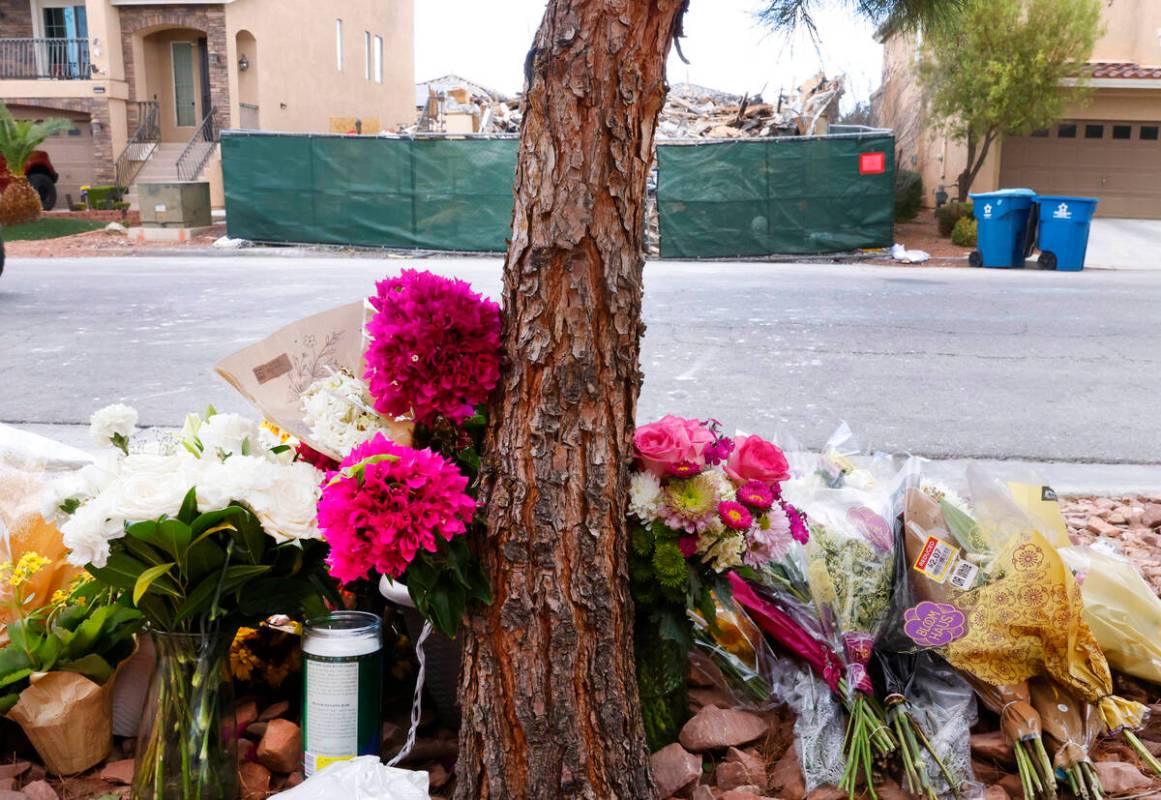‘There may not be closure’: Experts discuss challenges of fire investigations after 4 die

Clark County is still investigating the fire in southwest Las Vegas that claimed four lives last week, and experts said the process for trying to find the cause of such a fire can be slow and ultimately unsatisfying.
The investigative stage comes after an early morning fire last Thursday at 8332 Langhorne Creek St., the home of the Adem family. The Clark County coroner’s office has said the victims were 48-year-old Ibrahim Adem, 43-year-old Abdusalem Adem, 7-year-old Anaya Adem and 6-year-old Aaliyah Adem. The coroner’s office has not yet released cause and manner of death information.
Awet Adem previously provided different spellings for some of the victims’ names. His brothers Abdul and Ibrahim Adem died in the fire, along with Abdul Adem’s children Anaya and Aaliayh, he said Monday.
Fire investigations are complex and painstaking, according to experts, and in some cases, investigators can’t pinpoint a specific cause.
“Unfortunately, you’re given a deck of cards and it sounds like it’s not a full deck here,” said Joseph Toscano, who’s spent more than 40 years investigating fires for law enforcement, the insurance industry and the private sector.
At a Wednesday press conference, Clark County Fire Chief John Steinbeck said he would not have an update about what caused the fire.
“Fire investigations of this nature will take us months,” he said. “It’s a long process and we’re going to do a very thorough investigation.”
Collapse, demolition could add complications
During the fire, the roof, second and third floors of the house collapsed.
“The floors are completely burned through,” Steinbeck said.
Then, on Monday, the house was mostly demolished because officials were concerned it could collapse further and fall on neighboring homes, according to the county and demolition contractor Greg Barstow.
The demolition of the Adems’ home is “a problem,” and the collapse also adds challenges, according to Toscano.
If investigators can’t do a thorough investigation inside the building, “there are things that remain a mystery,” he said.
“Would we like the building to be completely up and undisturbed? Yes,” Steinbeck said Wednesday. But he said his investigators had been able to take lots of pictures and video footage.
A collapse during a fire could be caused when supports are compromised and a roof gives way and puts weight on the floor, according to Toscano. That can happen quickly in an intense fire.
“Fire takes away the structural integrity of a building,” said National Fire Protection Association Fire Investigator Robert Duval. Fires diminish structural members, such as beams and columns, and gravity can shift the building, triggering a collapse, he said.
“A conventional homicide scene is much easier”
Nevada Assistant State Fire Marshal Lt. Joe Rodriguez said investigators approach a fatal fire as if it’s a criminal incident until they can determine it’s not. “It’s a very involved and a very slow process,” he said.
Steinbeck said authorities had “a very high degree of confidence” that the fire was accidental, not intentional.
Experts say that “investigating a conventional homicide scene is much easier than investigating a fire scene,” said H. Butch Browning, executive director of the National Association of State Fire Marshals. Fire can damage or destroy evidence that could be seen with the naked eye at the scene of a homicide.
Investigators want to reconstruct the area where a fire occurred, said Browning. And they want to figure out the actions of the victims when the fire started and try to determine why those people died.
Typically, investigators start by talking to witnesses and the firefighters who initially responded, Browning said. Once they can enter the scene, investigators evaluate the structure for signs of fire spread. Then, they work from the least-burned to the worst-burned area, which is where they look for what caused the fire.
In the area where the fire started, investigators try to rule out potential causes, like whether it was intentionally set, he said. But he added that they may get down to a set of potential causes they can’t rule out.
Autopsies also are necessary and help investigators determine if people died in a fire or if a fire was used to cover up a crime, according to Duval.
Medical examiners will assess thermal burns to the victims’ bodies, he said, as well as the carbon monoxide levels in the victims’ blood and the damage to their respiratory tracts. High carbon monoxide levels and respiratory tract burns can indicate they inhaled a lot of smoke, he said.
A second investigation possible
Insurance company fire investigators likely will conduct their own secondary investigation, said Dan Heenan, a former Bureau of Alcohol, Tobacco, Firearms and Explosives fire investigator who later led Clark County’s fire investigations unit.
They will likely bring in a crane and try to excavate the structure to figure out where the fire started, he said. If they can do that, they’ll examine potential heat sources in that area and inspect each one to see if the fire damaged it internally or externally.
Internal damage can suggest a fire started in an item, and investigators could then send that object to a lab for analysis, he said.
An insurance company wants that information so it can sue parties that might be responsible for the fire to recoup costs, he said.
On television, Duval said, everything gets solved in 45 minutes. Fire investigations are less predictable.
“Unfortunately, at the end, it may be undetermined,” he said. “There may not be closure.”
Contact Noble Brigham at nbrigham@reviewjournal.com. Follow @BrighamNoble on X.